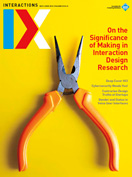Authors:
Jonas Löwgren
The notion of making seems to be gaining some traction lately. When I talk to people outside academia about interaction design and new media, making often comes up, with references to physical computing, 3D printing, and Maker Faires, and overtones of grassroots activism and yet another this-changes-everything movement. I note a corresponding increase in the interaction design research discourse—but here, the word is used slightly more broadly to include construction, programming, and other craft-like activities forming part of the core of traditional design practice. That is also the sense in which I will be using the word here. In…
You must be a member of SIGCHI, a subscriber to ACM's Digital Library, or an interactions subscriber to read the full text of this article.
GET ACCESS
Join ACM SIGCHIIn addition to all of the professional benefits of being a SIGCHI member, members get full access to interactions online content and receive the print version of the magazine bimonthly.
Subscribe to the ACM Digital Library
Get access to all interactions content online and the entire archive of ACM publications dating back to 1954. (Please check with your institution to see if it already has a subscription.)
Subscribe to interactions
Get full access to interactions online content and receive the print version of the magazine bimonthly.






